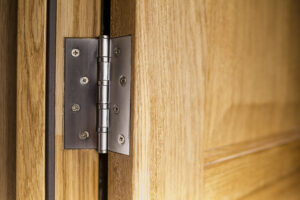Get to Know the Different Types of Door Hinges

*Updated May 15th, 2025
With the wide variety of door hinges available on the market today, making the right choice for your home can get confusing. In this comprehensive guide, we break down the different door hinge types, materials, finishes, and proper installation techniques. We’ll explore all the factors to consider when selecting durable, smooth-functioning, and aesthetically pleasing hinges for any door in your house. Additionally, it’s essential to consider the specific types of doors for your home, as each may require different hinge styles for optimal performance. We will also discuss the importance of weight and thickness in your door selection, ensuring that you choose hinges that can withstand daily use while maintaining functionality. By the end of this guide, you’ll be well-equipped to make an informed decision that enhances both the safety and aesthetic appeal of your living space.
You’ll learn the distinguishing features and best uses of common hinge varieties like classic butt hinges, piano hinges for extra support, and concealed cabinet door hinges out of sight. We also provide a detailed look at hinge materials from stainless steel to brass, as well as finishes ranging from antique bronze to polished chrome.
And to ensure your new door hinges operate flawlessly for years, we’ve included a step-by-step installation guide. Follow along to measure and mount hinges properly while avoiding common mistakes. With the right information, you’ll be able to upgrade existing doors or install new interior and exterior doors outfitted with the ideal hinge system to match functionality needs and style preferences.
So let’s dive in and explore the different types of door hinges, types of door hinge finishes, and types of door hinge materials available.
Understanding Door Hinge Types
Door hinge types vary in their design, function, and application, and choosing the right one for your door can make all the difference. It’s important to consider factors such as door weight, size, and frequency of use when selecting the right door hinge.
Some common types include:
- Butt Hinges: These are the most common type of door hinge and are ideal for standard interior doors. They are affordable, easy to install, and come in various sizes.
- Piano Hinges: Also known as continuous hinges, they are designed for doors that need extra support along the entire length.
- Concealed Hinges: As the name implies, these hinges are hidden from view when the door is closed, and are commonly used for cabinet doors and full-length doors.
- Ball Bearing Hinges: These are ideal for doors that require a smooth and quiet motion. They are suitable for heavy doors and high traffic areas.
Specialty Door Hinges and Their Uses
While standard butt hinges get the job done in most homes, there are plenty of lesser-known hinge styles that can solve specific problems or add a cool design element to your space. Let’s take a look at a few specialty hinges you might want to consider:
Pivot Hinges
These hinges are mounted at the top and bottom of the door rather than on the side, which allows the door to pivot open. They’re perfect for extra-heavy or oversized doors, like glass shower doors or tall front entry doors, because they can better support the weight. Plus, they look sleek and modern—definitely a stylish upgrade.
Strap Hinges
If you’re going for a farmhouse or rustic look, strap hinges are a great fit. You’ll often see them on barn doors, garden gates, or decorative outdoor shutters. They have long, flat arms that add character and charm while providing sturdy support.
Spring Hinges
Ever wish your door would just close itself? That’s where spring hinges come in handy. They use built-in tension to automatically close the door after it’s opened. These are super helpful for garage entry doors, laundry rooms, or anywhere you want the door to shut on its own without a second thought.
Offset Hinges
These clever hinges shift the door slightly out of the frame when it opens, which can actually give you up to an extra inch of clearance. That may not sound like much, but it can make a big difference for accessibility—especially for walkers, wheelchairs, or even just moving bulky furniture through a tight space.
Exploring Door Hinge Materials and Finishes
Door hinge materials vary in strength, durability, and appearance. The most popular materials used to manufacture door hinges are:
- Steel: this is the most commonly used material because of its strength, durability, and easy maintenance.
- Brass: this material offers a high level of aesthetic appeal and is perfect for matching with traditional or vintage-style doors.
- Stainless steel: this material is corrosion-resistant, making it an excellent option for exterior doors. It also has a sleek and modern look.
- Aluminum: this material is lightweight and corrosion-resistant, making it perfect for exterior doors exposed to weather elements.
Aside from material, the finish is also important in choosing the right door hinge. The finish gives the hinge a finished look that matches the overall style of the door. Here are some common types of door hinge finishes:
- Powder-coated: this is a durable finish that can withstand extreme weather conditions and scratches. It is available in a wide range of colors.
- Polished: this finish gives the door hinge a shiny and reflective look that is perfect for contemporary and modern-style doors.
- Satin: this finish is similar to polished finish but less shiny, giving the hinge a subtle and understated look.
- Antique: this finish gives the door hinge a classic, old-world charm that complements traditional-style doors.
Choosing Hinges to Match Your Door Hardware
When you’re updating or replacing door hardware, it’s easy to focus on the flashy stuff—like handles, knobs, or locks. But don’t overlook your hinges! They might be small, but they play a big role in tying everything together. Matching your hinges to your other hardware is a simple way to make your space feel polished and intentional.
Match Finishes for a Cohesive Look
If your doorknobs are satin nickel, going with bright brass hinges will look a little off. Try to stick with the same finish—or at least complementary tones. Satin nickel, matte black, oil-rubbed bronze, and polished chrome are all popular options, and many brands offer entire hardware collections in matching finishes to make this easier.
Think About Open-Concept Spaces
In open floor plans, where you can see multiple rooms and doors at once, hardware consistency is key. If your kitchen has black cabinet pulls and your living room doorknobs are brushed gold, your eye might catch that mismatch (even if guests don’t say anything). Choose a unified finish for hinges and other hardware elements that flow from room to room. It helps everything feel connected and thoughtfully designed.
Mixing Finishes?
Now, if you’re intentionally mixing finishes (like matte black and brass), that can totally work—it just needs to look curated rather than accidental. Stick to a pattern (e.g., black knobs and hinges, brass lighting) to avoid visual chaos.
Bottom line: Hinges might seem like background players, but when they match your other hardware, they quietly elevate your entire space.
Door Hinge Installation Guide
Proper door hinge installation is vital to ensure smooth and robust door operation. Follow these step-by-step instructions below for optimal results.
Step 1: Gather the Necessary Tools
- Screwdriver
- Drill
- Chisel
- Hammer
- Tape measure
Step 2: Choosing the Best Door Hinge Type
When selecting your door hinge, it is essential to take into consideration your door’s weight and size. For lighter and smaller doors, a standard butt hinge will be sufficient. For heavier and larger doors, consider using a heavy-duty hinge, such as a ball bearing hinge, for added support.
Step 3: Prepare the Surface for Hinge Installation
- Measure and mark the placement of the hinges on the door and the frame of the doorway.
- Using a chisel and hammer, carve out the recesses for the hinges on the door and frame.
- Ensure that the hinges are flush with the surface to prevent any door misalignment.
Step 4: Install the Door Hinges
- Attach the hinges to the door first using a drill and screws.
- Next, attach the hinges to the frame of the doorway using screws and a drill.
- Ensure that the hinges are level and secure.
Step 5: Test the Door
After hinge installation, test the door’s operation to ensure that it opens and closes smoothly. If adjustments are necessary, make them until the door operates correctly.
Troubleshooting Common Hinge Issues
Even the best-installed hinges can cause headaches over time. If your door’s acting up—maybe it’s squeaking, sticking, or suddenly doesn’t close quite right—you’re not alone. These common hinge problems are super fixable once you know what to look for.
Misaligned Hinges
If your door looks crooked or rubs against the frame, your hinges might not be lined up properly. This can happen from wear and tear, or if the door wasn’t mounted just right to begin with. You can usually fix this by loosening the screws, adjusting the hinge slightly, and tightening everything back into place. A level and a steady hand are your best friends here!
Door Sagging
Over time, heavy doors—or even lightweight doors that get a lot of use—can start to sag, making them hard to close or causing them to drag on the floor. The culprit? Usually loose or worn-out top hinges. Try tightening the screws first. If that doesn’t help, consider upgrading to heavy-duty or ball bearing hinges, or shimming behind the hinge to lift the door back into alignment.
Loose Screws or Stripped Holes
You’ve got your screwdriver out and… the screws just spin in place. Ugh. That’s a sign the screw holes in the door or frame have become stripped. Quick fix: try using longer screws that reach deeper into the wood, or fill the holes with toothpicks and wood glue before re-driving the screws in. (Yep, that trick actually works!)
Noisy or Sticky Hinges
If your door squeaks every time someone opens it, you’re due for a little hinge TLC. Most squeaks are caused by metal-on-metal friction. Just apply a bit of lubricant—like silicone spray or even a dab of petroleum jelly—and open and close the door a few times to work it in. If your door sticks or feels “gritty,” check for dirt buildup or rust. A quick clean and lube usually does the trick.
Conclusion
Now that you have a detailed understanding of the different types of door hinges, materials, finishes, and installation methods, you are equipped to make an informed decision. Consider the specific needs of your pet and the location of the door when selecting the appropriate hinge type. Additionally, if you plan on installing a pet door effectively, ensure that you choose the right size and placement to suit your furry friend’s comfort and ease of access. Taking these factors into account will not only enhance functionality but also contribute to the overall aesthetic of your space.
Remember that choosing the right door hinge is necessary for smooth functionality and durability of your door. Whether you are looking for a hinge with a specific finish, material, or design, this guide has provided you with a comprehensive buyer’s resource to aid in your decision-making process.
FAQ
What are the different types of door hinges?
There are several types of door hinges, including butt hinges, continuous hinges, pivot hinges, strap hinges, and barrel hinges. Each type has its own unique characteristics and is suitable for different applications and door styles.
What are the different types of door hinge finishes?
Door hinges come in a variety of finishes, such as polished brass, satin nickel, antique bronze, stainless steel, and black. The finish you choose can complement the overall aesthetic of your door and enhance its appearance.
What materials are door hinges made from?
Door hinges can be made from various materials, including steel, brass, bronze, aluminum, and stainless steel. Each material has its own strengths and weaknesses, such as durability, corrosion resistance, and cost.
How to select the right door hinge?
To select the right door hinge, consider factors such as the door weight, door material, door thickness, and the desired aesthetic. You should also ensure that the hinge is compatible with your door frame and other hardware.

Anna has over six years of experience in the home services and journalism industries and serves as the Content Manager at MyHomePros.com, specializing in making complex home improvement topics like HVAC, roofing, and plumbing accessible to all. With a bachelor’s degree in journalism from Auburn University, she excels in crafting localized, comprehensive guides that cater to homeowners’ unique needs. Living on both coasts of the United States has equipped her with a distinctive perspective, fueling her passion for turning any house into a cherished home through informed, personalized decision-making.
Connect with top-rated local contractors who can help you with siding, roofing, HVAC, windows, and more. Get free quotes from verified professionals in your area today.








